Michael Shanks
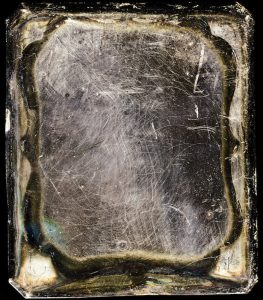
Ghosts in the Mirror
A collection of worn and damaged daguerreotypes
link

Ghosts in the Mirror
A collection of worn and damaged daguerreotypes
link
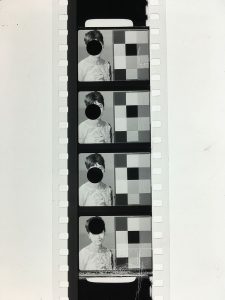
Photographs of (most often) women that sometimes appear in the countdown that begins every reel of motion picture film meant for exhibition, often accompanied by color bars.
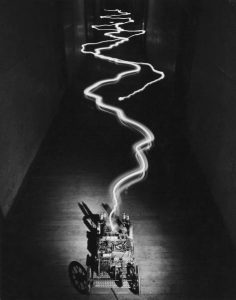
Wiener’s Moth 1949
link
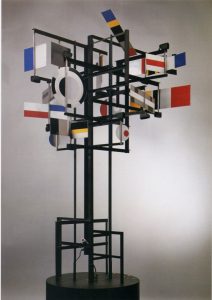
spatiodynamic sculpture
link
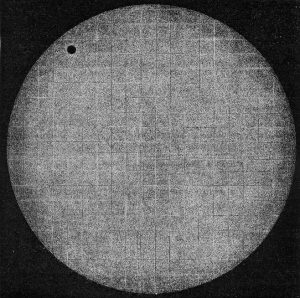
photographic revolver
In 1873, Jules Janssen (1824-1907) presented to the Commission for Venusian solar transits, his « revolver method » for solving in an objective and permanent way the difficult problem of determing the exact moment of contact of the planet Venus with the solar disc.
link
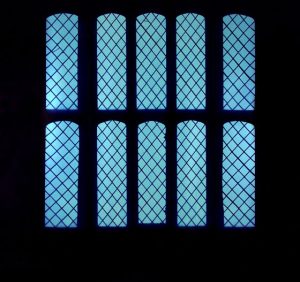
The Latticed Window, Lacock Abbey
Knowing of the resonance of the place, and the philosophical implications of the window image, Neusüss covered the interior of the window with photographic paper at night. He exposed the paper by shining a light from outside. The resulting photogram recreates the subject of Talbot’s negative.
Box shaped aerial camera with propeller at front. Camera attaches to
the bottom of airplane; propeller provides power for film advance.
ca. 1915
link
A tachistoscope is a device that displays an
image for a specific amount of time.
wiki
Scientific film made by E.J. Marey in 1891.
Marey films blood transmission
Marey Films (XII) body motions
Lithophane
A lithophane is an etched or molded artwork in thin very translucent porcelain that can only be seen clearly when back lit with a light source. It is a design or scene in intaglio that appears “en grisaille” (in gray) tones.
Identifies Additive Color Theory 1666
Light refracted with a prism splits white light into its basic component colors: red, orange, yellow, green, blue and violet.
link
The tartan ribbon photo, the first permanent color photograph.
The first permanent color photograph was taking in 1861 by physicist James Clerk Maxwell who used what is known as the ‘color separation’ method, shooting three separate black and white photos using three filters: red, green, and blue. He then projected the three images registered with their corresponding filters overlapping them to create a color image.
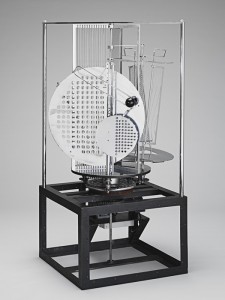
light space modulator
youtube
So Many Light Space Modulators
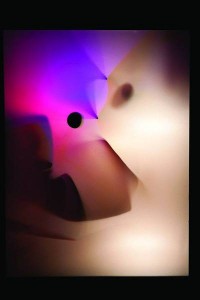
‘Aparelho Cinecromático (cinechromatic machines)’, 1964.
link
“project compositions of color light forms moving on semi-clear surfaces”
leonardo
Heart Beats Dust – Cone Pyramid, 1968
In a black rectangular box, a window at eye level opens onto a 24′ cube which houses the sculpture. The form is created by thrusting dust up into a cone of light. The dust is Lithol Rubine, a brilliant red pigment chosen for its ability to remain suspended in air for long periods. The thrust is achieved by amplified heart-beats from an attached stethoscope or a continuous loop tape recording of heartbeats played on a speaker mounted directly under a tightly stretched rubber membrane upon which the dust sits.
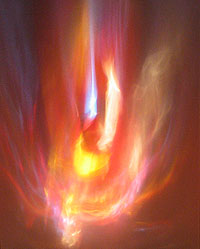
A freeze-frame image of:
Early Clavilux Jr, ca. 1930.
Conventional artists manipulate materials [stone, pigments, etc.]. These ‘objects’ reflect light into our eyes to form the images they want us to see. If there were no light, we could not experience their art. In contrast, Wilfred ‘sculptured’ light directly.
The Image of a living horse projected inside
a camera obscura onto a tilted stone plaquette.
“Small random holes in Paleolithic hide tents coincidentally
and occasionally created camera obscuras, which projected
moving images inside the dwelling spaces, triggering profound
spiritual, philosophical, and aesthetic advances.”
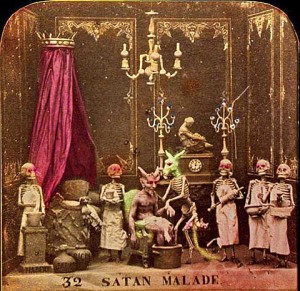
Anon, “Satan Malade,” from Les Diableries, c. 1861,
hand-tinted stereocard (detail)
Certainly the most remarkable body of work made for stereo viewing, however, wasLes Diableries, a suite of 72 cards published anonymously in Paris, 1861. Produced during the rise of the Second Empire, Les Diableries‘s sculptural visions of satanic torture and merriment would have meant swift imprisonment for the artists under Napoleon III’s authoritarian rule.
Pepper’s ghost is an illusion technique used in theatre, haunted houses, dark rides, and magic tricks. It is named after John Henry Pepper, a scientist who popularized the effect in a famed demonstration in 1862.
link
Luminous-Lint has been constructed collaboratively over the last decade to share information on the history of photography worldwide.
Link
Captain Jonathan W. Walker’s Branded Hand
Daguerreotype, 1845
“A Florida seamen originally from Cape Cod, Captain Jonathan Walker was sympathetic to the plight of the slaves. In 1844 he made an unsuccessful attempt to aid a group of seven to freedom by sailing them to the West Indies. Walker paid for his part in the venture with a year in solitary confinement, a $600.00 fine, and the branded letters “s.s.” for “slave stealer” on his right palm.“
From The Daguerreotypes of Southworth & Hawes
Daguerrotype of Couple Holding Daguerrotype Unknown Artist-1850
link
“The eye is like a mirror, and the visible object is like
the thing reflected in the mirror.”
— Avicenna, early 11th century
In 1936 Walker Evans photographed the Burroughs, a family of sharecroppers in Depression era Alabama. In 1979 in Sherrie Levine rephotographed Walker Evans’ photographs from the exhibition catalog “First and Last.” In 2001 Michael Mandiberg scanned these same photographs, and created AfterWalkerEvans.com and AfterSherrieLevine.com to facilitate their dissemination as a comment on how we come to know information in this burgeoning digital age.
Copyright © 2023